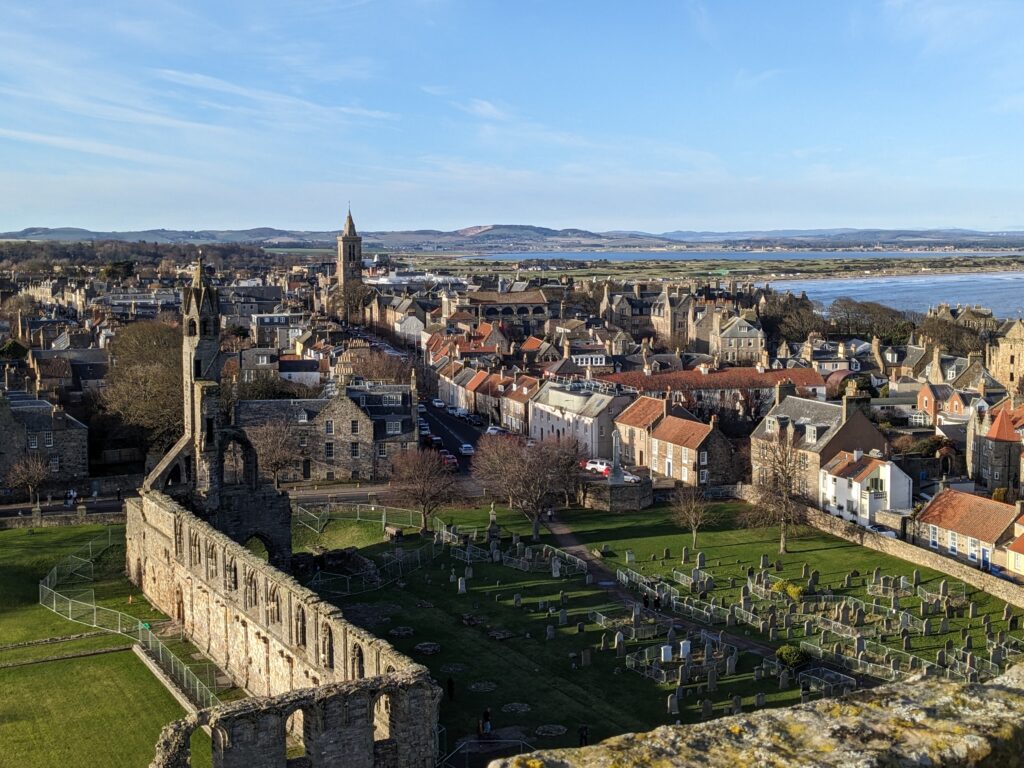
In June 1559 St Andrews witnessed a revolution. Inspired by the preaching of John Knox, discontented local residents joined with armed Protestant activists to purge the city of ‘all monuments of idolatry’. Religious images were burnt, altars smashed, and mass books destroyed. The upheavals were so drastic the ‘doctors’ of the university were shocked into silence, becoming ‘as dumb as their idols who were burnt in their presence’.
With astonishing speed St Andrews was transformed from Scotland’s Catholic religious capital (once praised as the second Rome) into a proudly Protestant community. In 1561 local officials boasted that St Andrews was ‘long’ reformed, and noted the prevalence of ‘sincere preaching’ and the abolition of ‘all public idolatry’. Not long after, in 1564, the St Andrews Kirk Session claimed that ‘a perfect reformed kirk’ had been ‘seen within this city by the space of five years’.
For a brief period it seemed as though St Andrews might become an ideal Protestant city, and an example to the rest of Scotland. Yet the dream did not last long. As the elders of the kirk session were boasting of the perfection of their church, the Earl of Moray was already remarking on St Andrews’ ‘poverty and decay’. By 1593 the provost and bailies of St Andrews were regretting ‘the miserable estate and poverty whereunto the said burgh is presently reduced’, and complaining that ‘their whole common works, such as their pier and shore, their ports and causeways’ with which the ‘city of old was decorated, are altogether become ruinous and decayed’.
In St Andrews religious change was accompanied by economic crisis. Before the disturbances of 1559, St Andrews was Scotland’s fifth richest urban centre. Yet unlike other major east coast burghs (such as Dundee or Perth) its wealth was only partly built on trade. Instead, St Andrews profited from its role as the administrative heart of Catholicism in Scotland.
Praised as ‘chief and mother city of the realm’, pre-Reformation St Andrews was home to the kingdom’s most important cathedral and the seat of the country’s first archbishop. Its busy church courts brought a stream of litigants to the city, travelling ‘for to seek law’. Meanwhile scholars old and young came to the university to pursue ‘divine and human learning’.
For much of the fifteenth and early sixteenth centuries St Andrews seemed to be thriving, and the city saw an expansion in religious foundations. In the 150 years before the Reformation three new university colleges and two new friaries were established in St Andrews. Existing religious organisations also underwent development, with the parish church of Holy Trinity being completely rebuilt, and major construction work taking place at the Cathedral (including the heightening and remodelling of the wall which still surrounds the Cathedral precinct).
This ecclesiastical building boom was funded by revenues drawn from across eastern Scotland. St Andrews’ religious institutions had estates spreading from Aberdeenshire down to the border with England. Major foundations such as the Cathedral, the Collegiate Church of St Mary on the Rock, and the university colleges of St Salvator, St Leonard, and St Mary profited from teinds (or tithes) diverted from more than fifty parishes in lowland Scotland. The Cathedral alone received more than 600 tonnes of grain a year, much of which was then processed at the abbey mills, including at a new watermill down by St Andrews Harbour (built by the Cathedral around 1518).
The financial arrangements of Scotland’s pre-Reformation Church have often been criticised. Yet they made a place like St Andrews possible, sustaining not merely major religious foundations, but supporting a wider service economy within the city. The system may have been flawed, but it was functioning, until torn apart by the upheavals of 1559.
When the Reformers embarked on their programme of religious transformation, many hoped that the wealth of the Catholic Church would be directed to worthy causes, ‘to hospitals, schools, and other Godly uses’. The reality proved less satisfactory. In the aftermath of 1559 the crown, local nobles, former churchmen, and the burgh council all carved up religious assets. Robert Pont, who briefly served as minister of St Andrews, later claimed that ‘from the year of our Lord 1560… the greatest study of all men of power of this land… has been… to spoil the kirk of Christ of its patrimony.’ Yet it was not just the powerful who contributed to the collapse of St Andrews’s religious economy. The post-Reformation period saw non-payment of rents and teinds on an unprecedented scale. With the archbishop gone, and the administrative structures of the Catholic Church abolished or disintegrating, even organisations which survived 1559 faced huge problems enforcing payment. Some, like St Salvator’s College, became caught up in litigation lasting decades; others resignedly concluded with the masters of St Leonard’s College that there was no point suing for non-payment as the ‘cost would over-gang the profit’.
The factors which undermined St Andrews’ religious economy were varied, but together they brought about one of the largest redistributions of property in St Andrews’ history. While certain individuals managed to ‘reap some earthly commodity’, as a community St Andrews became significantly poorer. Deprived of the wealth and protection of the Catholic hierarchy the city went into decline. By the seventeenth century visitors no longer marvelled at St Andrews’ splendour, but deemed the burgh ‘proud in the ruins of her former magnificence’.
Dr Bess Rhodes is an associate lecturer in Scottish history at the University of St Andrews and is a researcher for the Sacred Landscapes project. Her monograph Riches and Reform: Ecclesiastical Wealth in St Andrews, c. 1520-1580 is available from Brill.
See: https://brill.com/view/title/35029
This blogpost was previously published on the University of St Andrews School of History blog: https://standrewsschoolofhistory.wordpress.com/category/research/
